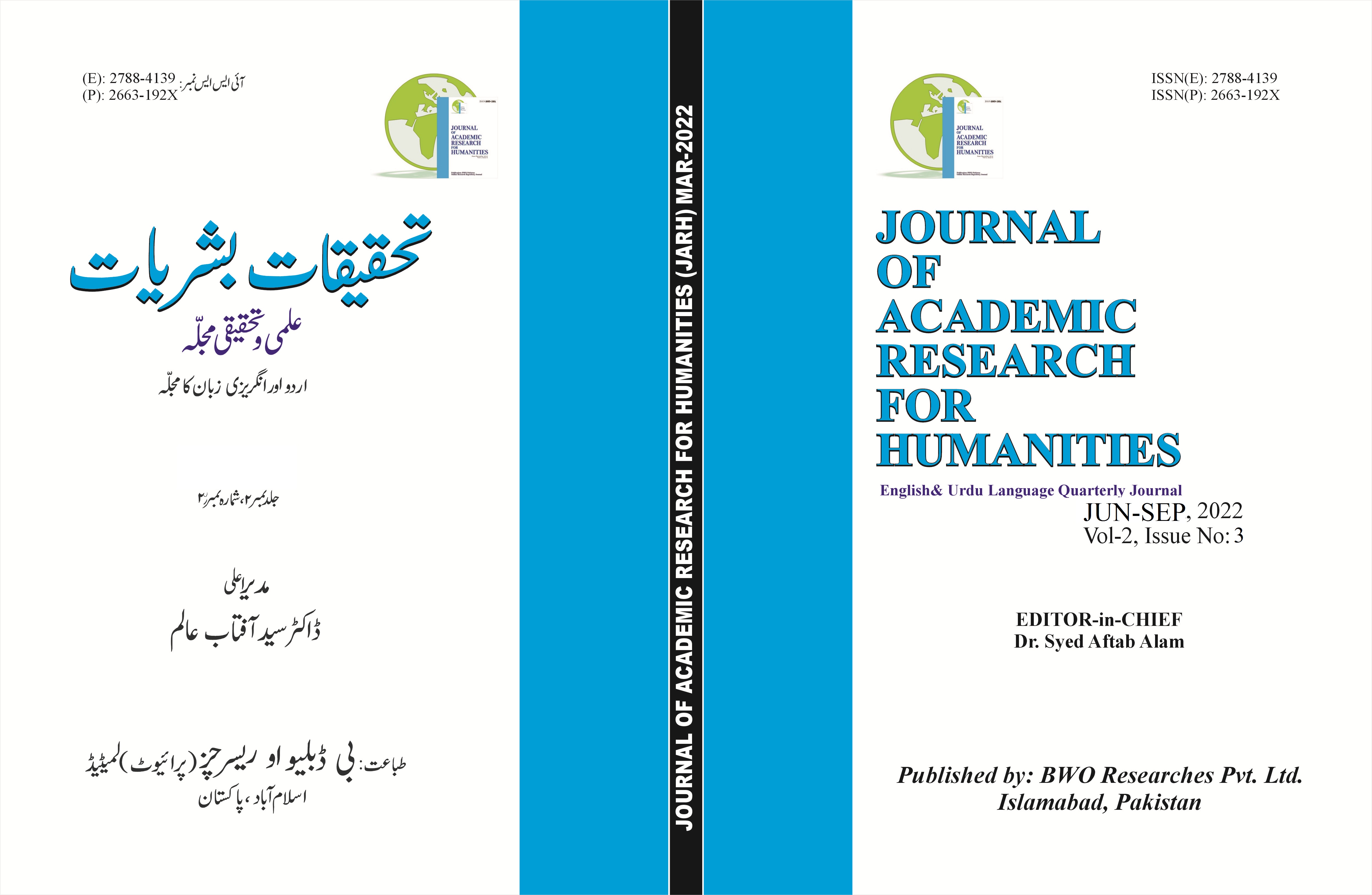Contemporary Economic Recovery Measures: An Analysis in the Context of Prophetic Era: معاشی بحالی کے معاصر اقدامات کا جائزہ،دور نبوی کے تناظر میں

Abstract
Economics plays a fundamental role in the integrity and development of a country. That is an economically strong country which provides a better quality of life to its citizens. Contemporarily, all the countries of the world are facing economic challenges. To improve their economic conditions and to get the economy out of the crisis, they are trying to take effective measures like the best use of available resources, encouraging investment, economic planning, and distribution of wealth, discouraging hoarding, and balance in consumption & saving. The Holy Prophet (PBUH) also the many measures for economic development which are reviewed in the paper and analysis is done to conclude the adaptability of those measures in the contemporary world. He (PBUH) discouraged hoarding and the ensured fair distribution of wealth. He (PBUH) provided facilities to the investors and ensure the protection of their rights. In this article, the narrative and comparative methods of research try to examine the economic recovery measures of the present day and in the era of the Prophet Muhammad (PBUH)
Keywords
Economic Crisis,Prophet Measures,Islamic History,best use of resources,tax system.
References
- References
- Al-Qur'an Al-Hakim Al-Mãhli, Ibn Hãzm, Abu Ali Muhammad, (384-456),
- Al-Mãhli, Bêirût, Da al-Fikr Kitãb al-Zakwãt, Issue, 725, Vol. 2,
- Al-Ansãri, Hamid, (1992), Islam's System of Government, Lahore: Maktabã Al-Hasan,
- Al-Tabrizi, Khãtib, (392-463 AH) Mishkãt alMasabih, translator, Maulana Abdul Aleem Alvi, Chapter Min La Tahl Lah Al-Masila, Hadith, 163, Lahore: Taj Company
- Al-Jãrjani, Saÿyid Sharif bin Ali bin Muhammad, (2003) Al-Tãrifat, Cairo: Dar al-Kitab al-Arabi, Al-Jisãs, Abu Bakr Ahmad, Al-Rãzi, A (917-981) Hakãm al-Qur’an, Meaning: Yahab Ali al-Imam in yafaal ma faila Yusuf aza khaf Hãlak Naas mïn alQaht, Karachi: Old Library, Vol. 3,
- Al-Hãsakfi, Al-Shaykh Alãuddin, S, N, Rid alMukhtar Ali Tanvir al-Absar, Delhi: Muttaba Mujtabai, vol. 2,
- Al-Sãhili, Abd al-Rahman, Al-Rãwd al-Anaf, Cairo: Maktaba al-Khanji, Vol. 2,
- Al-Rãzi, Syed Al-Sharif, (2003), Nahj al-Balagha,translated by Mufti Jafar Hussain, Lahore: AlMiraj Company, Maktoob 53,
- Aurudnaxel itaiptapC, (2015), The effect of hoarding on economic growth for the prospective of capital theory, Procardia economics and finance, 20,
- Atique, Fairuz Salleh, Economic growth and resources use-what a link available at Flores.unu.edu/news/economic-growth-resourcesuse-what a link.html, retrieved on 14 May, 2022
- Brewster, H. and Yeboah D, (1994), Aid and growth income in aid favoured developing countries,
- policy issues, Cambridge Journal of Economics, vol. 18,
- Chapra, Muhammad Umer (1985). Towards a Just Monetary System: A Discussion of Money,
- Banking, and Monetary Policy in the Light of Islamic Teachings, Lahore: Islamic Foundation,
- Dailynewslounge.com/2019/5/21/13414.accessedMa y may, 24:30 PM30PM
- Downey, Gary Lee. 2021. “Critical Participation: Inflecting Dominant Knowledge Practices through
- STS.” p. 219 Elgaronline, retrieved from www.Elgaronline.dom/viev/9781783476435/chap
- ter01.xhtml
- Gosh, B.N and Rama Gosh. (1991). Economic growth, Development and Planning, New Delhi: Deep and
- Deep Publications,
- Farooqui, Yusuf, (2006), Formation of Society and State in Muhammad, Prophethood, Lahore: Azharul-Qur'an,
- Ghani and Din M., (2006). The impact of public investment on economic growth in Pakistan, The
- Pakistan development review, vol. 45, No.1,
- Greg Duperies, what are ways economic growth can be achieved, www.livestopedia.com. Accessed 22
- April 2022 5:52 Am
- Ibn Manzoor, Muhammad bin Makrãm, (2010), Lasan al-Arab, Bêirut: Dar Sadir, Vol. 4, Jhang New. (2020).
- https//:jang.com.pk/news/752312//dailypakistan.c om.pk/30 march 2020. Accessed 15 May 2022.
- Khurshid Ahmad, (1977), Khilafãt Rashida Economic Review, Delhi: Muktaba Burhan, Mansoor Puri, Qazi Muhammad Salman, (1867- 1930), Rahmat llal Alamin, Lahore: Sheikh
- Ghulam and Sanjj, 1,Contemporary Economic Recovery Measures Journal of Academic Research for Humanities 2(3) (Sep-2022)
- Maqbool Hossain, Maida Hossain, the role of investment in the course of economic growth in
- Pakistan, world academy of Science and engineering and technology,66,2010,
- Muslim Ibn Al-Hajjãj, Al-Qashiri (206.261), AlSahih, Beirut: Dar Ibn Sadir, Kitab Al-Masaqat, Chapter, Tahrim al-Ihtkar Fi Al-Aqwat, H, 4122
- MD journal Abdin, Relationship between taxation and economic development of a country, SSRN papers,
- ID 3295458
- Naseer, Ahmad Naseer, (1934-1997). The Great Prophet and the Last, Lahore: Feroze Sons Ohanian, Lee E., Taylor, John B., Wright, (2012).
- Government Policies and the Delayed Economic Recovery, London: Hoover Institution Press Publication
- Rahman, Dr Naeem, Economic behaviour about acquisition and consumption of wealth: comparison of Islam and Secure viewpoint, Uloom e Islamia, vol. 27, issue 1, Rose Ackerman, Corruption & Governance, Available at www.openyls.law.yale.edu,15-4-2022,4:30PM
- The New Encyclopedia Britannica (The University of Chicago, 15th edition), vol. 4,
- Qaradawi, Yusuf, (1983), Allama, Fiqh al-Zakwat, translated Sajid al-Rahman Siddiqui, Lahore: Al
- Badr Publication, Vol. 1, United Nations Development Programme (UNDP)
- Human Development Report.
- Walter Ouma young, (1970) Administration Aspects of Development Planning and Plan implementation (Nairobi, Institute for Development Studies),
- Zafar, Abdul Rauf (2005), Essays on Prophethood, Bahawalpur: Islamia University,
